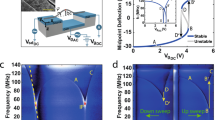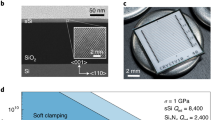Abstract
Carbon nanotube mechanical resonators have attracted considerable interest because of their small mass, the high quality of their surfaces, and the pristine electronic states they host1,2,3,4. However, their small dimensions result in fragile vibrational states that are difficult to measure. Here, we observe quality factors Q as high as 5 × 106 in ultra-clean nanotube resonators at a cryostat temperature of 30 mK, where we define Q as the ratio of the resonant frequency over the linewidth. Measuring such high quality factors requires the use of an ultra-low-noise method to rapidly detect minuscule vibrations, as well as careful reduction of the noise of the electrostatic environment. We observe that the measured quality factors fluctuate because of fluctuations of the resonant frequency. We measure record-high quality factors, which are comparable to the highest Q values reported in mechanical resonators of much larger size5,6, a remarkable result considering that reducing the size of resonators is usually concomitant with decreasing quality factors. The combination of ultra-low mass and very large Q offers new opportunities for ultra-sensitive detection schemes and quantum optomechanical experiments.
This is a preview of subscription content, access via your institution
Access options
Subscribe to this journal
Receive 12 print issues and online access
$259.00 per year
only $21.58 per issue
Buy this article
- Purchase on Springer Link
- Instant access to full article PDF
Prices may be subject to local taxes which are calculated during checkout



Similar content being viewed by others
References
Chaste, J. et al. A nanomechanical mass sensor with yoctogram resolution. Nature Nanotech. 7, 301–304 (2012).
Steele, G. A. et al. Strong coupling between single-electron tunneling and nanomechanical motion. Science 325, 1103–1107 (2009).
Lassagne, B., Tarakanov, Y., Kinaret, J., Garcia-Sanchez, D. & Bachtold, A. Coupling mechanics to charge transport in carbon nanotube mechanical resonators. Science 325, 1107–1110 (2009).
Benyamini, A., Hamo, A., Viola Kusminskiy, S., von Oppen, F. & Ilani, S. Real-space tailoring of the electron–phonon coupling in ultra-clean nanotube mechanical resonators. Nature Phys. 10, 151–156 (2014).
Adiga, V. P. et al. Approaching intrinsic performance in ultra-thin silicon nitride drum resonators. J. Appl. Phys. 112, 4323 (2012).
Poot, M. & van der Zant, H. S. J. Mechanical systems in the quantum regime. Phys. Rep. 511, 273–335 (2012).
Li, M., Tang, H. X. & Roukes, M. L. Ultra-sensitive NEMS-based cantilevers for sensing, scanned probe and very high-frequency applications. Nature Nanotech. 2, 114–120 (2007).
Mahboob, I. & Yamaguchi, H. Bit storage and bit flip operations in an electromechanical oscillator. Nature Nanotech. 3, 275–279 (2008).
Aspelmeyer, M., Meystre, P. & Schwab, K. Quantum optomechanics. Phys. Today 65, 29 (July, 2012).
Rieger, J., Isacsson, A., Seitner, M. J., Kotthaus, J. P. & Weig, E. M. Energy losses of nanomechanical resonators induced by atomic force microscopy-controlled mechanical impedance mismatching. Nature Commun. 5, 3345 (2014).
Tao, Y., Boss, J. M., Moores, B. A. & Degen, C. L. Single crystal diamond nanomechanical resonators with quality factors exceeding one million. Nature Commun. 5, 3638 (2014).
Chan, J., Safavi-Naeini, A. H., Hill, J. T., Meenehan, S. & Painter, O. Optimized optomechanical crystal cavity with acoustic radiation shield. Appl. Phys. Lett. 101, 081115 (2012).
Anetsberger, G., Rivière, R., Schliesser, A., Arcizet, O. & Kippenberg, T. J. Ultralow-dissipation optomechanical resonators on a chip. Nature Photon. 2, 627–633 (2008).
Chan, J. et al. Laser cooling of a nanomechanical oscillator into its quantum ground state. Nature 478, 89–92 (2011).
Ni, K-K. et al. Enhancement of mechanical Q factors by optical trapping. Phys. Rev. Lett. 108, 214302 (2012).
Gieseler, J., Deutsch, B., Quidant, R. & Novotny, L. Subkelvin parametric feedback cooling of a laser-trapped nanoparticle. Phys. Rev. Lett. 109, 103603 (2012).
Gröblacher, S. et al. Demonstration of an ultracold micro-optomechanical oscillator in a cryogenic cavity. Nature Phys. 5, 485–488 (2009).
Villanueva, L. G. & Schmid, S. Evidence of surface loss as ubiquitous limiting damping mechanism in SiN micro- and nanomechanical resonators. Preprint at http://arxiv.org/pdf/1405.6115 (2014).
Meerwaldt, H. B., Johnston, S. R., van der Zant, H. S. J. & Steele, G. A. Submicrosecond-timescale readout of carbon nanotube mechanical motion. Appl. Phys. Lett. 103, 053121 (2013).
Gouttenoire, V. et al. Digital and FM demodulation of a doubly clamped single-walled carbon-nanotube oscillator: towards a nanotube cell phone. Small 6, 1060–1065 (2010).
Eichler, A. et al. Nonlinear damping in mechanical resonators made from carbon nanotubes and graphene. Nature Nanotech. 6, 339–342 (2011).
Moser, J. et al. Ultrasensitive force detection with a nanotube mechanical resonator. Nature Nanotech. 8, 493–496 (2013).
Ganzhorn, M. & Wernsdorfer, W. Dynamics and dissipation induced by single-electron tunneling in carbon nanotube nanoelectromechanical systems. Phys. Rev. Lett. 108, 175502 (2012).
Gavartin, E., Verlot, P & Kippenberg, T. J. Stabilization of a linear nanomechanical oscillator to its thermodynamic limit. Nature Commun. 4, 2860 (2013).
Fong, K. Y., Pernice, W. H. P. & Tang, H. X. Frequency and phase noise of ultrahigh Q silicon nitride nanomechanical resonators. Phys. Rev. B 85, 161410(R) (2012).
Villanueva, L. G. et al. Surpassing fundamental limits of oscillators using nonlinear resonators. Phys. Rev. Lett. 110, 177208 (2013).
Dykman, M. I. & Krivoglaz, M. A. Theory of nonlinear oscillator interacting with a medium. Sov. Phys. Rev. 5, 265–441 (1984).
Eichler, A., Moser, J., Dykman, M. I. & Bachtold, A. Symmetry breaking in a mechanical resonator made from a carbon nanotube. Nature Commun. 4, 2843 (2013).
Barnard, A. W., Sazonova, V., van der Zande, A. M. & McEuen, P. L. Fluctuation broadening in carbon nanotube resonators. Proc. Natl Acad. Sci. USA 109, 19093 (2012).
Longenecker, J. G. et al. High-gradient nanomagnets on cantilevers for sensitive detection of nuclear magnetic resonance. ACS Nano 6, 9637–9645 (2012).
Laird, E. A., Pei, F., Tang, W., Steele, G. A. & Kouwenhoven, L. P. A high quality factor carbon nanotube mechanical resonator at 39 GHz. Nano Lett. 12, 193–197 (2012).
Schneider, B. H., Etaki, S., van der Zant, H. S. J. & Steele, G. A. Coupling carbon nanotube mechanics to a superconducting circuit. Sci. Rep. 2, 599 (2012).
Cleland, A. N. & Roukes, M. L. Noise processes in nanomechanical resonators. J. Appl. Phys. 92, 2758–2769 (2002).
Acknowledgements
The authors thank H. Flyvbjerg and S. Nørrelykke for discussions. The authors acknowledge support from the European Union through the ERC-carbonNEMS project (279278), a Marie Curie grant (271938) and the Graphene Flagship, MINECO and FEDER (MAT2012-31338), the Catalan government (AGAUR, SGR), and the US Army Research Office.
Author information
Authors and Affiliations
Contributions
J.M. developed the experimental set-up, carried out the measurements and analysed the data. A.E. fabricated the devices. J.G. provided support for the experimental set-up. M.I.D. and A.B. provided support for the analysis. M.I.D. wrote Supplementary Section X. J.M., M.I.D. and A.B. wrote the manuscript, with critical comments from all authors. A.B. and J.M. conceived the experiment. A.B. supervised the work.
Corresponding author
Ethics declarations
Competing interests
The authors declare no competing financial interests.
Supplementary information
Supplementary information
Supplementary Information (PDF 1690 kb)
Rights and permissions
About this article
Cite this article
Moser, J., Eichler, A., Güttinger, J. et al. Nanotube mechanical resonators with quality factors of up to 5 million. Nature Nanotech 9, 1007–1011 (2014). https://doi.org/10.1038/nnano.2014.234
Received:
Accepted:
Published:
Issue Date:
DOI: https://doi.org/10.1038/nnano.2014.234
This article is cited by
-
Long-lived electronic spin qubits in single-walled carbon nanotubes
Nature Communications (2023)
-
Artificial-intelligence-assisted mass fabrication of nanocantilevers from randomly positioned single carbon nanotubes
Microsystems & Nanoengineering (2023)
-
Dry Etching Fabrication for Ring Vibration Resonator Based on Quartz
Silicon (2023)
-
Pumping and Cooling of Nanomechanical Vibrations Generated by Cooper-Pair Exchange
Journal of Low Temperature Physics (2023)
-
Signatures and detection prospects for sub-GeV dark matter with superfluid helium
Journal of High Energy Physics (2023)



